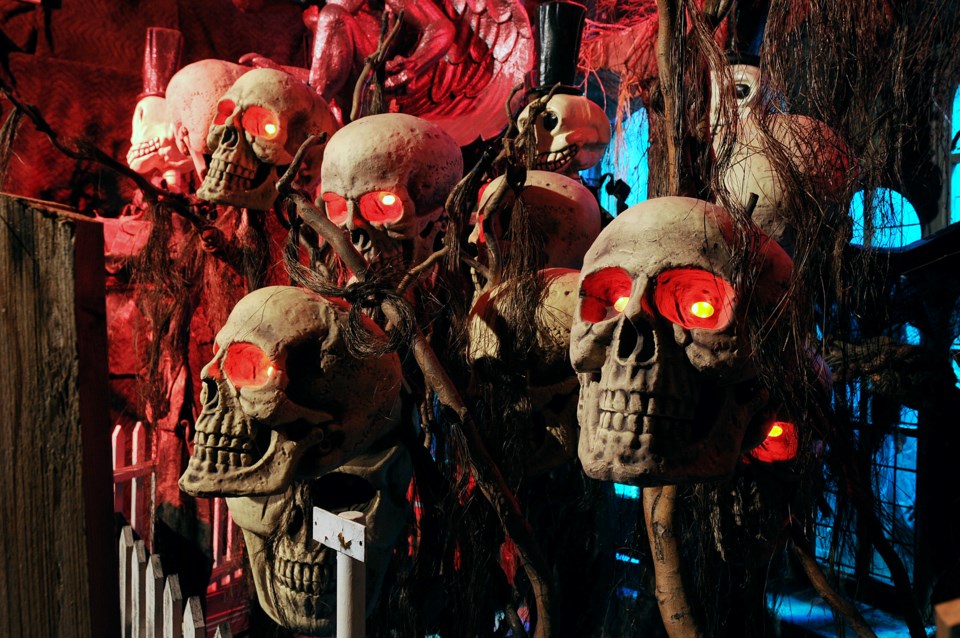We avoid confronting death. As individuals, many of us frolic through our days pretending we will live forever. As a society, we quickly pull the cover up over anything that reminds us of mortality. The funeral industry is a good illustration. At least among Vancouverites of European Christian background, when a family member “passes,” we call a number to set in motion a process that collects the body, performs an almost industrial renovation and shoots them out the other side in an otherworldly gift box, head nestled among layers of satin.
And yet, for one day a year, we cast aside our inhibitions and engage with the most explicit forms of the macabre.
It is perhaps a hangover from our hang-ups that even now, when we cheerfully confront demons, we do so in a way that seems the opposite of the way we confront actual mortality. Instead of hiding death and prettying it up, on Halloween we caricature it and make it as unabashedly grotesque as we can. We admire the most ghastly costumes. This may not be so much the opposite of our denial as another form of it. By making fun of death (and its accompanying cultural accoutrements: ghosts, demons, skeletons, the undead, et al) are we confronting it, or candy-coating it? (I intend to explore Vancouverites’ cultural approaches to death in an upcoming multi-part series “Dead of Winter.” Keep reading.)
The Mexican tradition of Dia de Muertos, Day of the Dead, seems to me closer to a healthy relationship between the living and the departed. While accompanied by costumes equally or more macabre than our own best Halloween finery, families also take the time to visit the graves of their ancestors. This is a more in-your-face confrontation with death.
Here, we might dress up as an anonymous dead person, but it would be over the line to dress up as, say, one’s recently deceased aunt. In the Mexican tradition, there is an intersection of death as a source of merrymaking and as a real fact of life. Here, we like to keep those two more neatly segregated.
Our own Halloween tradition is one of those religious and cultural mashups that was probably usurped from pre-existing “pagan” rites, which marked the completion of the harvest cycle and the temporary death represented by winter.
Halloween — contracted from All Hallow’s Eve — is the night before All Saints Day, when Christians mourn the deaths of the saints (“hallows”). The evening before was, at times, when church towers and town crier bells would peal, calling Christians to pray for souls in purgatory. In parts of Europe, people would go door to door offering prayers in exchange for food.
Playing pranks — the work of unsettled souls — emerged in the past couple of centuries, as did the hollowing out of turnips and other vegetables to form the pained faces of the eternally damned. Dressing in costume seems to have multiple explanations. Pagans are believed to have smeared themselves with ashes from the sacred bonfire, while some later Europeans apparently believed, counterintuitively, that they could ward off evil spirits by dressing like them. In many cultures, there is, or was, a belief that this was the one day a year when departed souls returned to the family hearth.
Leave it to the French to imagine a carnival of the dead, in which the burial grounds came to life for one night only, in a sensual bacchanal. In fact, the variety of traditions is so immense that what may be most noteworthy about Halloween (and its sibling festivals disguised by other names) is that it has been practised so widely across the Christian world for so long. And, whether it allows us to confront death, in a way, or laugh in its face, Halloween seems an outlet, of sorts, for our issues around the inevitable.
Kids may not be going to church in any great numbers these days, but they still cling tenaciously to this ancient Christian-based festival. Of course, what drives tradition today may be less ethereal and more material. Because who, after all, doesn’t like Smarties and Twizzlers?
twitter.com/Pat604Johnson



